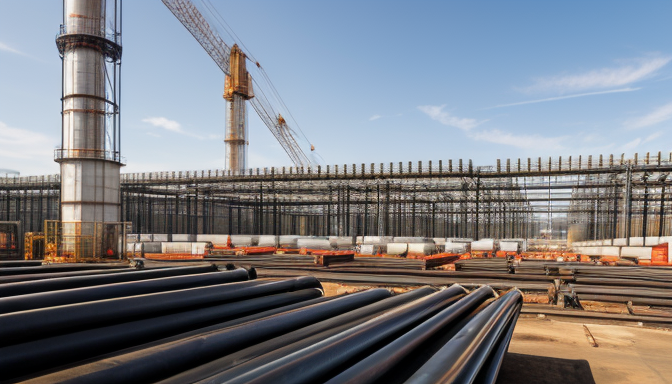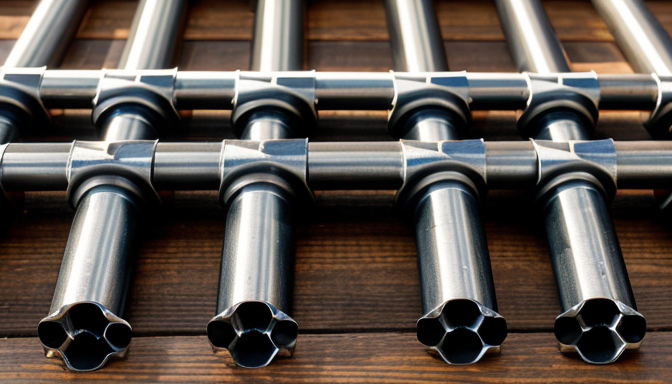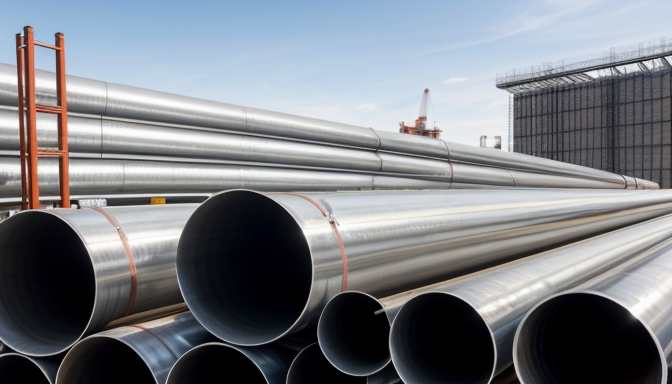When it comes to transporting natural gas, steel pipes are the backbone of the industry. They are designed to withstand high pressures and harsh conditions, making them essential for safe and efficient gas distribution. But what exactly makes these pipes so important? Let’s explore the key aspects of natural gas steel pipes, including their price, weight, properties, sizes, and various uses in the industry.
Understanding the pricing dynamics of natural gas steel pipes is crucial for budgeting and procurement. Prices can vary based on several factors, including:
- Material Quality: Higher quality steel often comes at a premium.
- Market Demand: Prices can fluctuate based on demand in the energy sector.
- Manufacturing Costs: Changes in labor and production costs can affect pricing.
Additionally, the size and thickness of the pipe also play a significant role in determining the final cost. For instance, a thicker pipe designed for high-pressure applications will typically be more expensive than a standard pipe. Keeping an eye on market trends can help you make informed purchasing decisions.
The weight of natural gas steel pipes is another critical factor. Heavier pipes may be more durable, but they can also complicate transportation and installation. For instance, a standard 10-inch natural gas steel pipe can weigh anywhere from 30 to 50 pounds per foot, depending on its thickness. This weight is important to consider because:
- Transportation: Heavier pipes require more robust transport methods.
- Installation: Lifting and maneuvering heavier pipes can be challenging.
In many cases, engineers must balance the need for strength with the practicalities of handling and installing these pipes.
Natural gas steel pipes possess unique properties that make them suitable for gas transportation. These properties include:
- Strength: Steel pipes can handle high pressures without deforming.
- Durability: They are designed to last for decades, even in harsh environments.
- Corrosion Resistance: Many pipes are treated to resist rust and corrosion, extending their lifespan.
These characteristics ensure that natural gas can be transported safely and efficiently, reducing the risk of leaks or failures.
Choosing the right size of natural gas steel pipes is essential for effective system design. Standard sizes range from 1 inch to over 24 inches in diameter. Each size has its specific applications:
- Small Diameter Pipes: Often used in residential applications.
- Large Diameter Pipes: Commonly utilized in industrial settings.
When designing a gas distribution system, it’s crucial to consider the flow rate and pressure requirements to select the appropriate pipe size.
Natural Gas Steel Pipe Price
Understanding the pricing dynamics of natural gas steel pipes is crucial for anyone involved in the industry. Whether you’re a contractor, engineer, or purchasing manager, knowing the costs can make or break your project budget. Prices can vary significantly based on several factors, and getting a grip on these can save you both time and money.
One of the primary factors influencing the price of natural gas steel pipes is the material cost. Steel prices fluctuate due to market demand, availability, and even geopolitical events. For instance, when steel mills face disruptions, prices can spike, impacting your procurement plans. Additionally, the thickness and grade of the steel also play a role. Higher-grade materials that offer better durability and resistance will generally come at a premium.
Another important aspect is the size and diameter of the pipes. Larger pipes require more material, which naturally increases the price. But it’s not just about the size; the complexity of the manufacturing process can also add to the cost. For example, pipes that require special coatings or treatments to resist corrosion will typically be more expensive than standard options.
Transportation costs are yet another factor. If you’re sourcing pipes from a distant supplier, shipping fees can add up quickly. This is especially true for heavy steel pipes, which can be costly to transport. Therefore, buying from local suppliers can sometimes be more economical, even if their base prices are slightly higher.
To give you a clearer picture, here’s a simple table summarizing the average price ranges for natural gas steel pipes based on size and grade:
| Pipe Size (inches) | Grade | Average Price per Foot |
|---|---|---|
| 2 | Grade B | $5 – $7 |
| 4 | Grade B | $8 – $10 |
| 6 | Grade X42 | $12 – $15 |
| 8 | Grade X52 | $16 – $20 |
Lastly, keep an eye on market trends. Prices can shift based on seasonal demand, economic conditions, and even technological advancements in manufacturing. Staying informed can help you make better purchasing decisions. So, when planning your next project, remember that understanding the price of natural gas steel pipes is not just about numbers; it’s about making strategic choices that can lead to successful outcomes.

Natural Gas Steel Pipe Weight
The weight of natural gas steel pipes is not just a number; it’s a critical factor that influences many aspects of the gas distribution process. Imagine trying to transport a heavy load without knowing how much it weighs. It would be a logistical nightmare! In the world of natural gas, understanding pipe weight helps in planning transportation, installation, and overall system efficiency.
Generally, the weight of these pipes varies based on their diameter and wall thickness. For instance, a larger diameter pipe will naturally weigh more than a smaller one. This can impact everything from transportation costs to the type of machinery needed for installation. When planning a project, knowing the weight is essential. It helps in determining the right equipment and even the number of workers needed on-site.
Here’s a quick breakdown of how weight can influence different areas:
- Transportation: Heavier pipes require more robust vehicles and possibly special permits for transport.
- Installation: Lifting heavy pipes demands specific machinery, which can increase costs.
- Support Structures: The heavier the pipe, the more support it needs, affecting the design of the entire system.
To give you a clearer picture, let’s take a look at a simple comparison of weights for various sizes of natural gas steel pipes:
| Pipe Diameter (inches) | Wall Thickness (inches) | Weight (lbs per foot) |
|---|---|---|
| 2 | 0.154 | 10.79 |
| 4 | 0.237 | 28.68 |
| 6 | 0.280 | 37.60 |
| 8 | 0.322 | 48.30 |
As you can see from the table above, the weight increases as the diameter and wall thickness of the pipe increase. This is a crucial consideration for engineers and project managers. They need to ensure that the transportation and installation processes are feasible, without compromising safety.
In conclusion, the weight of natural gas steel pipes is a vital element in the overall planning and execution of gas distribution projects. It affects everything from costs to safety and efficiency. So, the next time you hear about pipe weight, remember, it’s not just about numbers; it’s about making informed decisions that lead to successful outcomes.
Natural Gas Steel Pipe Properties
Natural gas steel pipes are not just any pipes; they are the backbone of gas transportation systems. Why? Because they offer a unique blend of properties that make them ideal for carrying natural gas safely and efficiently. Let’s dive into these properties and see why they matter.
First off, strength is a key property. These pipes are designed to withstand high pressures. Imagine trying to hold a balloon filled with air. If the balloon is weak, it bursts easily. Similarly, the strength of steel pipes ensures they don’t fail under pressure. This is crucial, especially when transporting gas over long distances.
Next, we have durability. Natural gas steel pipes are built to last. They can endure harsh weather conditions and the wear and tear of daily use. Think of them as the sturdy shoes you wear for a long hike. You want something that won’t give up halfway through. This durability translates to lower maintenance costs over time, making them a smart choice for many industries.
Another important property is corrosion resistance. Natural gas can be harsh on materials. Over time, without proper protection, pipes can corrode and fail. However, many natural gas steel pipes are coated or treated to resist corrosion. This means they can last longer and perform better. It’s like putting on a raincoat before heading out in a storm. It keeps you dry and comfortable.
In addition to these properties, the thermal conductivity of steel is another factor to consider. Steel pipes can handle varying temperatures, which is essential in gas systems where temperatures can fluctuate. They help maintain the integrity of the gas being transported, ensuring it reaches its destination safely.
Lastly, let’s not forget about the ease of installation. Natural gas steel pipes are typically available in various sizes and weights. This versatility allows for easier handling and installation. For example, lighter pipes can be easier to maneuver in tight spaces, while heavier pipes may be used in high-pressure applications. This adaptability makes them suitable for a wide range of projects.
In summary, the properties of natural gas steel pipes—strength, durability, corrosion resistance, thermal conductivity, and ease of installation—make them a vital component in the gas industry. Understanding these properties can help in making informed decisions about which pipes to use in specific applications. After all, choosing the right pipe is like selecting the right tool for a job; it can make all the difference.

Natural Gas Steel Pipe Sizes
Choosing the right size of natural gas steel pipes is not just a matter of convenience; it’s a critical factor that can affect the overall efficiency of gas distribution systems. Imagine trying to fit a square peg in a round hole. It just doesn’t work, right? The same principle applies here. If the pipe size is off, it can lead to leaks, inefficiencies, and even safety hazards. So, understanding the standard sizes available is essential for anyone involved in the industry.
Natural gas steel pipes come in various diameters and wall thicknesses. The most common sizes range from 2 inches to 24 inches in diameter. But why does this matter? Well, the size you choose affects the flow rate of the gas, which in turn impacts everything from heating systems to industrial applications. For instance, larger pipes can carry more gas but may require more robust support systems. It’s a balancing act.
Here’s a quick overview of standard sizes and their typical applications:
| Pipe Diameter (inches) | Typical Application |
|---|---|
| 2 | Residential heating |
| 4 | Commercial buildings |
| 6 | Small industrial use |
| 10 | Medium industrial applications |
| 24 | Large-scale gas distribution |
When selecting a size, consider the following factors:
- Flow Rate: How much gas do you need to transport?
- Pressure Requirements: Higher pressures may require thicker walls.
- Installation Environment: Will the pipes be above ground or underground?
It’s also worth noting that the wall thickness of the pipes can vary. Thicker walls are typically needed for high-pressure applications, while thinner walls may suffice for lower pressures. This can affect not only the weight of the pipes but also their cost. A heavier pipe may cost more to transport and install, so it’s essential to factor that into your budget.
In conclusion, understanding the sizes of natural gas steel pipes is crucial for effective system design and implementation. It’s not just about picking a number; it’s about ensuring safety, efficiency, and reliability in gas distribution. So, the next time you’re faced with a choice, remember: the right size can make all the difference.
Frequently Asked Questions
- What are natural gas steel pipes used for?
Natural gas steel pipes are primarily used for transporting natural gas from extraction sites to processing facilities and ultimately to consumers. They are essential in ensuring safe and efficient gas distribution across vast distances.
- How is the price of natural gas steel pipes determined?
The price of natural gas steel pipes is influenced by several factors, including raw material costs, manufacturing processes, market demand, and transportation expenses. Keeping an eye on these factors can help you budget better for procurement.
- What is the typical weight of natural gas steel pipes?
The weight of natural gas steel pipes varies based on their diameter and wall thickness. Generally, heavier pipes are used for high-pressure applications, while lighter pipes are suitable for lower pressure systems. Knowing the weight is crucial for transportation and installation planning.
- What properties make natural gas steel pipes suitable for gas transportation?
Natural gas steel pipes are known for their exceptional strength, durability, and resistance to corrosion. These properties ensure that they can withstand high pressures and harsh environmental conditions, making them ideal for long-term gas transportation.
- What sizes do natural gas steel pipes come in?
Natural gas steel pipes come in a variety of standard sizes to fit different applications. Common sizes range from small-diameter pipes used in residential settings to large-diameter pipes for industrial use. Choosing the right size is crucial for effective system design.
